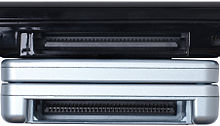
Nintendo DS
Background to the schools Wikipedia
This content from Wikipedia has been selected by SOS Children for suitability in schools around the world. Before you decide about sponsoring a child, why not learn about different sponsorship charities first?
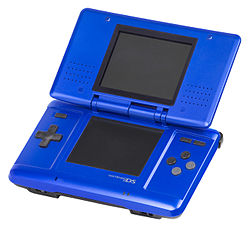 An electric blue original Nintendo DS. |
|
| Developer | Nintendo |
| Manufacturer | Foxconn |
| Product family | Nintendo DS |
| Type | Handheld game console |
| Generation | Seventh generation era |
| Release date |
|
| Retail availability | 2004–2007 |
| Discontinued | 2007 |
| Units sold | Worldwide: 157.69 million, all models combined (as of December 31, 2012) ( details) |
| Media | Nintendo DS Game Card Game Boy Advance cartridge |
| CPU | One 67.028 MHz ARM946E-S and one 33.514 MHz ARM7TDMI |
| Storage capacity | 4 MB RAM Cartridge save |
| Connectivity | Wi-Fi |
| Online services | Nintendo Wi-Fi Connection |
| Best-selling game | New Super Mario Bros., 29.09 million (as of March 31, 2012) |
| Backward compatibility |
Game Boy Advance (DS & DS Lite only) |
| Predecessor | Game Boy Advance ( Game Boy line) |
| Successor | Nintendo DS Lite (redesign) Nintendo DSi (redesign) Nintendo DSi XL (redesign) Nintendo 3DS (successor) |
The Nintendo DS (ニンテンドーDS Nintendō DS) is a dual-screen handheld game console developed and released by Nintendo. The device went on sale in North America on November 21, 2004. The DS, short for "dual screen", introduced distinctive new features to handheld gaming: an LCD screen working in tandem with a touchscreen, a built-in microphone, and support for wireless connectivity. Both screens are encompassed within a clamshell design similar to the Game Boy Advance SP. The Nintendo DS also features the ability for multiple DS consoles to directly interact with each other over Wi-Fi within a short range without the need to connect to an existing wireless network. Alternatively, they can interact online using the Nintendo Wi-Fi Connection service.
Prior to its release, the Nintendo DS was marketed as a "third pillar" in Nintendo's console lineup, meant to complement the Game Boy Advance and GameCube. However, backward compatibility with Game Boy Advance titles and strong sales ultimately established the new handheld console as the successor to the Game Boy series. On March 2, 2006, Nintendo launched the Nintendo DS Lite, a slimmer and lighter redesign of the original Nintendo DS with brighter screens. On November 1, 2008, Nintendo released the Nintendo DSi, another redesign with several hardware improvements and new features. As of December 31, 2012, all Nintendo DS models combined have sold 153.67 million units, making it the best selling handheld game console to date, and the second best selling video game console of all time, behind the PlayStation 2.
History
On November 13, 2003, Nintendo announced that they would be releasing a new game product in 2004. The company didn't provide many details, but stated it would not succeed the Game Boy Advance or GameCube. On January 20, 2004, the console was announced under the codename "Nintendo DS" (which initially stood for Developer's System). Nintendo only released a few details at that time, saying that the console would have two separate, 3-inch TFT LCD display panels, separate processors, and up to 1 gigabit of semiconductor memory. Nintendo president Satoru Iwata said, "We have developed Nintendo DS based upon a completely different concept from existing game devices in order to provide players with a unique entertainment experience for the 21st century." He also expressed optimism that the DS would help put Nintendo back at the forefront of innovation and move away from the conservative image that has been described about the company in years past. In March 2004, the codename was changed to "Nitro" and a document containing most of the console's technical specifications was leaked. In May 2004, the codename was changed back to "Nintendo DS" and the console was shown in prototype form at the Electronic Entertainment Expo (E3). All the features of the console were revealed by Nintendo at E3. On July 28, 2004, Nintendo revealed a new design, one that was described as "sleeker and more elegant" than the one shown at E3. Also, the codename "Nintendo DS" became the official name of the console that day.
Launch
On September 20, 2004, Nintendo announced that the Nintendo DS would be released in North America on November 21, 2004 for US$149.99. It was set to release on December 2, 2004 in Japan (¥15000); on February 24, 2005 in Australia ($199.95); and on March 11, 2005 in Europe (£99.99/€149.99). The console was released in North America with a midnight launch event at Universal CityWalk EB Games in Los Angeles, California. The console was launched quietly in Japan compared to the North America launch; one source cites the cold weather as the reason. Regarding the European launch, Nintendo President Satoru Iwata said:
Europe is an extremely important market for Nintendo, and we are pleased we can offer such a short period of time between the US and European launch. We believe that the Nintendo DS will change the way people play video games and our mission remains to expand the game play experience. Nintendo DS caters for the needs of all gamers whether for more dedicated gamers who want the real challenge they expect, or the more casual gamers who want quick, pick up and play fun.
Hardware
The Nintendo DS design resembles that of the multi-screen games from the Game & Watch line, such as Donkey Kong and Zelda, which was also made by Nintendo.
The lower display of the Nintendo DS is overlaid with a touchscreen designed to accept input from the included stylus, the user's fingers, or a curved plastic tab attached to the optional wrist strap. The touchscreen allows users to interact with in-game elements more directly than by pressing buttons; for example, in the included chatting software, PictoChat, the stylus is used to write messages or to draw.
The handheld features four lettered buttons (X, Y, A, B), a directional pad, and Start, Select, and Power buttons. On the top of the device are two shoulder buttons, a game card slot, a stylus holder and a power cable input. The bottom features the Game Boy Advance game card slot. The overall button layout resembles that of the Super Nintendo Entertainment System controller. When using backward compatibility mode on the DS, buttons X and Y and the touchscreen are not used as the Game Boy Advance line of systems do not feature these controls.
It also has stereo speakers providing virtual surround sound (depending on the software) located on either side of the upper display screen. This is a first for a Nintendo handheld, as the Game Boy line of systems has only supported stereo sound through the use of headphones or external speakers. A built-in microphone is located below the left side of the bottom screen. It has been used for a variety of purposes, including speech recognition, chatting online between and during gameplay sessions, and minigames that require the player to blow or shout into the microphone.
Technical specifications
| Mass | Dimensions | Display | Resolution | CPU | RAM | Input | Voltage | Battery | Storage | Wireless connectivity |
|---|---|---|---|---|---|---|---|---|---|---|
| 275 g (9.7 oz) | 148.7 mm wide × 84.7 mm deep × 28.9 mm high (5.85 in. × 3.33 in. × 1.13 in.) | Two TFT LCD screens: 62 mm × 46 mm (2.4 in × 1.8 in), 77 mm (3.0 in) diagonal, 0.24 mm dot pitch, 18-bit depth (262,144 colors), 21 mm gap between screens (~92 lines) |
256 × 192 pixels | Two ARM processors:
|
4 MB (expandable via the Game Boy Advance slot, only officially used by the Opera web browser) |
|
1.65 v | Rechargeable 850 mAh lithium-ion battery. | 256 kB of serial flash memory | Built-in 802.11 Wireless Network Connection ( WEP encryption support only) |
The system's 3D hardware performs transform and lighting, texture-coordinate transformation, texture mapping, alpha blending, cel shading, and z-buffering; however, it uses point ( nearest neighbour) texture filtering, leading to some titles having a blocky appearance. Unlike most 3D hardware, it has a set limit on the number of triangles it can render as part of a single scene; the maximum amount is about 6144 vertices, or 2048 triangles per frame. The 3D hardware is designed to render to a single screen at a time, so rendering 3D to both screens is difficult and decreases performance significantly. The DS is generally more limited by its polygon budget than by its pixel fill rate. There are also 512 kilobytes of texture memory, and the maximum texture size is 1024 × 1024 pixels.
The system has 656 kilobytes of video memory and two 2D engines (one per screen). These are similar to (but more powerful than) the Game Boy Advance's single 2D engine; however, the cores are divided into the main core and sub core. Only the main core is capable of vertex 3D rendering.
The Nintendo DS has compatibility with Wi-Fi ( IEEE 802.11 (legacy mode)). Wi-Fi is used for accessing the Nintendo Wi-Fi Connection, compete with other users playing the same Wi-Fi compatible game, PictoChat or with a special cartridge and RAM extension, browse the internet.
Nintendo claims the battery lasts a maximum of 10 hours under ideal conditions on a full four-hour charge. Battery life is affected by multiple factors including speaker volume, use of one or both screens, use of wireless connectivity, and use of backlight, which can be turned on or off in selected games such as Super Mario 64 DS. The battery is user-replaceable using only a Phillips-head screwdriver. After about 500 charges the battery life starts dropping.
Users can close the Nintendo DS system to trigger its 'sleep' mode, which pauses the game that is being played and saves battery life by turning off the screens, speakers, the wireless communications; however, closing the system while playing a Game Boy Advance game will not put the Nintendo DS into sleep mode, and the game will continue to run normally. Certain DS games (such as Animal Crossing: Wild World) also will not pause but the backlight, screens, and speakers will turn off. Additionaly, when saving the game in Pokémon Diamond and Pearl, Zoo Tycoon DS, SimCity DS, Tiger Woods PGA Tour, Digimon World Dawn, Mega Man Battle Network 5, or The Legendary Starfy, the DS will not go into sleep mode.
Firmware
Nintendo's own firmware boots the system. A health and safety warning is displayed first, then the main menu is loaded. The main menu presents the player with four main options to select: play a DS game, use PictoChat, initiate DS Download Play, or play a Game Boy Advance game. The main menu also has some secondary options such as date and time, GBA screen, and touchscreen calibration.
The firmware also features an alarm clock, several options for customization (such as boot priority for when games are inserted and GBA screen preference), and the ability to input user information and preferences (such as name, birthday, favorite colour, etc.) that can be used in games.
Features
Nintendo Wi-Fi Connection
The Nintendo Wi-Fi Connection is a free online game service run by Nintendo. Players with a compatible Nintendo DS game can connect to the service via a Wi-Fi network using a Nintendo Wi-Fi USB Connector or a wireless router. The service was launched in North America on November 14, 2005 with the release of Mario Kart DS. Various online games and a web browser are now available.
Download Play
With Download Play, it is possible for users to play multiplayer games with other Nintendo DS systems using only one game card. Players must have their systems within wireless range (up to approximately 65 feet) of each other for the guest system to download the necessary data from the host system.
Download Play is also utilized to migrate Pokémon from fourth generation games into the fifth generation Pokémon Black and White, an example of a task requiring two different game cards, two handheld units, but only one player.
Some Nintendo DS retailers feature DS Download Stations that allow users to download demos of upcoming and currently available DS games; however, due to memory limitations, the downloads are erased once the system is powered off. The Download Station is made up of 1 to 8 standard retail DS units, with a standard DS card containing the demo data. On May 7, 2008, Nintendo released the Nintendo Channel for download on the Wii. The Nintendo Channel uses Nintendo's WiiConnect24 to download Nintendo DS demos through the Nintendo Channel. From there, a user can select the game demo he/she wishes to play and, similar to the Nintendo DS Download Stations at retail outlets, download the demo (until the user turns off the console) to their DS' 4MB RAM.
In collaboration with fast food restaurant chain McDonald's, a service called "Nintendo Zone" will start in the Kanto, Chūkyō and Kansai regions of Japan. It is an extension of the DS Download Station that offers exclusive content to each area and demos of upcoming and currently available DS games. The DSi has the necessary software built-in to detect and use these zones, while previous versions require downloading the "Nintendo Zone Viewer".
Multi-Card Play
Multi-Card Play, like Download Play, allows users to play multiplayer games with other Nintendo DS systems. In this case, each system requires a game card. This mode is accessed from an in-game menu, rather than the normal DS menu.
PictoChat
PictoChat allows users to communicate with other Nintendo DS users within local wireless range. Users can enter text (via a small on screen keyboard), handwrite messages or draw pictures (via the stylus and touchscreen). There are four chatrooms (A, B, C, D) in which people can go to chat. Up to sixteen people can connect in any one room.
On Nintendo DS and Nintendo DS Lite systems users can only write messages in black. However, the DSi and DSi XL includes a new function, letting users write in either black or rainbow colored pen.
Compatibility
The Nintendo DS is backward compatible with Game Boy Advance (GBA) cartridges. The smaller Nintendo DS game cards fit into a slot on the top of the system, while Game Boy Advance games fit into a slot on the bottom of the system. The Nintendo DS is not compatible with games for the Game Boy Colour and the original Game Boy. The Sharp Z80 compatible processor used in the older systems is still included, and indeed necessary for some GBA games that use the older sound hardware.
The handheld does not have a port for the Game Boy Advance Link Cable, so multiplayer or GameCube-Game Boy Advance link-up modes are not available in Game Boy Advance titles. Only single player power is supported on the Nintendo DS.
The Nintendo DS only uses one screen when playing Game Boy Advance games. The user can configure the system to use either the top or bottom screen by default. The games are displayed within a black border on the screen, due to the slightly different screen resolution between the two systems (256 × 192 px (approx. 0.05 megapixels) for the Nintendo DS, and 240 × 160 px (approx. 0.04 megapixels) for the Game Boy Advance).
Nintendo DS games inserted into the top slot are able to detect the presence of specific Game Boy Advance games in the bottom slot. In many such games, either stated in the game during gameplay or mostly explained in the games' instruction manuals, extra content can be unlocked or added by starting the Nintendo DS game with the appropriate Game Boy Advance game inserted. Some of the content can stay permanently, even when the GBA game has been removed after content has been added.
Additionally, GBA slot can be used to house expansion paks, such as the Rumble Pak, the Nintendo DS Memory Expansion Pak, and the Guitar Grip for the Guitar Hero: On Tour series. The Nintendo DSi and the DSi XL do not have a second cartridge slot and cannot play Game Boy Advance games.
Regional division
The Nintendo DS is region free in the sense that any console will run a Nintendo DS game purchased anywhere in the world; however, the Chinese version games can only be played on the Chinese iQue DS, whose larger firmware chip contains the required Chinese character glyph images. Although the Nintendo DS of other regions cannot play the Chinese games, the iQue DS can play games of other regions. Also, as with Game Boy games, some games that require both players to have a Nintendo DS game card for multiplayer play will not necessarily work together if the games are from different regions (e.g. a Japanese Nintendo DS game may not work with a North American Nintendo DS game, even though some titles, such as Mario Kart DS and Pokémon Diamond and Pearl versions are mutually compatible). With the addition of the Nintendo Wi-Fi Connection, certain games can be played over the Internet with users of a different region game.
Some Wi-Fi enabled games (e.g. Mario Kart DS) allow the selection of opponents by region. The options are "Regional" ("Continent" in Europe) and "Worldwide", as well as two non-location specific settings. This allows the player to limit competitors to only those opponents based in the same geographical area. This is based on the region code of the game in use.
The Nintendo DSi, however, has a region lock for the DSiWare downloadable games, as well as DSi-specific cartridges. It still runs normal DS games of any region, however.
Accessories
Although the secondary port on the Nintendo DS does accept and support Game Boy Advance cartridges (but not Game Boy or Game Boy Colour cartridges), Nintendo has emphasized that its main intention for its inclusion was to allow a wide variety of accessories to be released for the system, the Game Boy Advance compatibility titles being a logical extension.
Due to the lack of a second port on the Nintendo DSi, it is not compatible with any accessory that uses it.
Rumble Pak
The Rumble Pak was the first official expansion slot accessory. In the form of a Game Boy Advance cartridge, the Rumble Pak vibrates to reflect the action in compatible games, such as when the player bumps into an obstacle or loses a life. It was released in North America and Japan in 2005 bundled with Metroid Prime Pinball. In Europe, it was first available with the game Actionloop, and later Metroid Prime Pinball. The Rumble Pak was also released separately in those regions.
Headset
The Nintendo DS Headset is the official headset for the Nintendo DS. It plugs into the headset port (which is a combination of a standard 3.5mm(1/8-inch) headphone connector and a proprietary microphone connector) on the bottom of the system. It features one earphone and a microphone, and is compatible with all games that use the internal microphone. It was released alongside Pokémon Diamond and Pearl in Japan, North America, and Australia.
Browser
On February 15, 2006, Nintendo announced a version of the cross-platform web browser Opera for the DS system. The browser can use one screen as an overview, a zoomed portion of which appears on the other screen, or both screens together to present a single tall view of the page. The browser went on sale in Japan and Europe in 2006, and in North America on June 4, 2007. Browser operation requires that an included memory expansion pak is inserted into the GBA slot. The DSi has an internet browser available for download from the Nintendo DSi shop for free.
Wi-Fi USB Connector
This USB-flash-disk-sized accessory plugs into a PC's USB port and creates a miniature hotspot/ wireless access point, allowing a Wii and up to five Nintendo DS units to access the Nintendo Wi-Fi Connection service through the host computer's Internet connection. When tried under Linux, it acts as a regular wireless adapter, connecting to wireless networks, an LED blinks when there is data being transferred. There is also a hacked driver for Windows XP/Vista to make it function the same way. The Wi-Fi USB Connector has been discontinued from retail stores.
MP3 Player
The Nintendo MP3 Player (a modified version of the device known as the Play-Yan in Japan) was released on December 8, 2006 by Nintendo of Europe at a retail price of £29.99/€30. The add-on uses removable SD cards to store MP3 audio files, and can be used in any device that features support for Game Boy Advance cartridges; however, due to this, it is limited in terms of its user-interface and functionality, as it does not support using both screens of the DS simultaneously, nor does it make use of its touch-screen capability. It is not compatible with the DSi, due to the lack of the GBA slot, but the DSi includes a music player via SD card. Although it stated on the box that it is only compatible with the Game Boy Micro, Nintendo DS and Nintendo DS Lite, it is also compatible with the Game Boy Advance SP and Game Boy Advance.
Guitar grip controller
The Guitar grip controller comes packaged with the game Guitar Hero: On Tour and is plugged into the GBA game slot. It features four colored buttons just like the ones that can be found on regular Guitar Hero guitar controllers for the stationary consoles, though it lacks the fifth orange button found on the guitar controllers. The DS Guitar Hero controller comes with a small "pick-stylus" (which is shaped like a guitar pick, as the name suggests) that can be put away into a small slot on the controller. It also features a hand strap. The game works with both the DS Lite and the original Nintendo DS as it comes with an adapter for the original DS. It is not compatible with the DSi or 3DS, due to the lack of GBA slot. The Guitar Grip also works with its sequels, Guitar Hero On Tour: Decades, Guitar Hero On Tour: Modern Hits, and Band Hero.
Hacking and homebrew
Since the release of the Nintendo DS, a great deal of hacking has occurred involving the DS's fully rewritable firmware, Wi-Fi connection, game cards that allow SD storage, and software use. There are now many emulators for the DS such as NES, SNES, Sega Master System, Sega Mega Drive, Neo-Geo Pocket, Neo-Geo MVS (arcade), as well as older handheld consoles like the Game Boy Colour.
There are a number of cards which either have built-in flash memory, or a slot which can accept an SD, or MicroSD (like the DSTT, R4 and ez-flash V/Vi) cards. These cards typically enable DS console gamers to use their console to play MP3s and videos, and other non-gaming functions traditionally reserved for separate devices.
In South Korea, many video game consumers exploit illegal copies of video games, including for the Nintendo DS. In 2007, 500,000 copies of DS games were sold, while the sales of the DS hardware units was 800,000.
Another modification device called Action Replay, manufactured by the company Datel, is a device which allows the user to input cheat codes that allows it to hack games, granting the player infinite " health", power-ups, access to any part of the game, etc.
Redesigns
Nintendo DS Lite
The Nintendo DS Lite (ニンテンドーDS Lite Nintendō Dī Esu Raito) is the first redesign of the Nintendo DS. While retaining the original model's basic characteristics, it features a sleeker appearance, and brighter screens. Nintendo considered a larger model of the Nintendo DS Lite for release, but decided against it as sales of the original redesign were still strong. As of December 31, 2012, shipments of the DS Lite have reached 93.85 million units worldwide, according to Nintendo.
Nintendo DSi
The Nintendo DSi (ニンテンドーDSi Nintendō DSi) is the second redesign of the Nintendo DS. It is based on the unreleased larger Nintendo DS Lite model. While similar to the previous DS redesign, new features include two 0.3 megapixel digital inner and outer cameras, a larger 3.25 inch display, internal and external content storage, compatiblitiy with WPA wireless encryption, and connectivity to the Nintendo DSi Shop. Backwards compatibility with Game Boy Advance games was removed.
Nintendo DSi XL
The Nintendo DSi XL (DSi LL in Japan) is a larger design of the Nintendo DSi, and the first model of the Nintendo DS family of consoles to be a size variation of a previous one. It features larger screens with wider view angles, improved battery life, and a greater overall size than the original DSi. While the original DSi was specifically designed for individual use, Nintendo president Satoru Iwata suggested that DSi XL buyers give the console a "steady place on a table in the living room", so that it might be shared by multiple household members.
Model comparison
| Nintendo DS | Nintendo DS Lite | Nintendo DSi | Nintendo DSi XL | |
|---|---|---|---|---|
| Model | 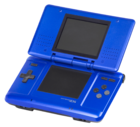 |
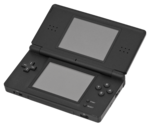 |
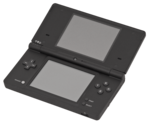 |
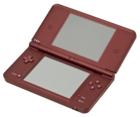 |
| Launch Price | ¥15,000 US$149.99 €149.99 £99.99 A$199.95 |
¥16,800 US$129.99 €149.99 £99.99 A$199.95 |
¥18,900 US$169.99 €169.99 £149.99 A$299.95 |
¥20,000 US$189.99 €179.99 £159.99 A$299.95 |
| Weight | 275 grams (9.7 oz) | 218 grams (7.7 oz) | 214 grams (7.5 oz) | 314 grams (11.1 oz) |
| Dimensions | 148.7 mm (5.85 in) wide × 84.7 mm (3.33 in) deep × 28.9 mm (1.14 in) high | 133 mm (5.2 in) wide × 73.9 mm (2.91 in) deep × 21.87 mm (0.861 in) high | 137 mm (5.4 in) wide × 74.9 mm (2.95 in) deep × 18.9 mm (0.74 in) high | 161 mm (6.3 in) wide × 91.4 mm (3.60 in) deep × 21.2 mm (0.83 in) high |
| Display | 3.0 in (76.20 mm) | 3.12 in (79.25 mm) | 3.25 in (82.55 mm) | 4.2 in (106.68 mm) |
| Backlight On/Off toggle | 4 backlight brightness levels | 5 backlight brightness levels | ||
| Camera | None | Front and rear-facing 0.3 MP sensors | ||
| Wi-Fi | Integrated 802.11 (only compatible with WEP or unencrypted networks) | Integrated 802.11b/g (may not be compatible with WPA/WPA2 in some cases) | ||
| Stylus | 75 mm (3.0 in) long × 4 mm (0.16 in) wide | 87.5 mm (3.44 in) long × 4.9 mm (0.19 in) wide | 92 mm (3.6 in) long × 4.9 mm (0.19 in) wide | 129.3 mm (5.09 in) long × 10 mm (0.39 in) wide pen stylus 96 mm (3.8 in) long × 4.9 mm (0.19 in) wide internal stylus |
| Game Boy Advance slot | Slot on the bottom labeled as SLOT-2 | None | ||
| Storage | Internal 256 kB NAND flash memory | Internal 256 MB NAND flash memory | ||
| Expandable via SD card slot | ||||
| Battery | 6 to 10 hours (850 mAh) |
15–19 hours on the lowest brightness setting 5–8 hours on the brightest (1000 mAh) |
9–14 hours on the lowest brightness setting 3–4 hours on the brightest (840 mAh) |
13–17 hours on the lowest brightness setting 4–5 hours on the brightest (1050 mAh) |
| Memory | 4 MB SRAM | 16 MB PSRAM | ||
| Expandable via Game Boy Advance slot | ||||
| Processor | 67.028 MHz ARM9 and 33.514 MHz ARM7 | 133 MHz ARM9 and 33.514 MHz ARM7 | ||
| Region Locking | All Nintendo DS hardware and software are region-free | Regional lockout for DSiWare and Nintendo DSi-enhanced software | ||
| Preloaded applications |
|
|
|
|
System sales and marketing
| Date | Japan | Americas | Other | Total |
|---|---|---|---|---|
| 2011-09-30 | 32.92 million | 56.19 million | 59.90 million | 149.00 million |
| 2011-12-31 | 32.96 million | 57.48 million | 60.61 million | 151.06 million |
| 2012-03-31 | 32.98 million | 57.76 million | 60.78 million | 151.52 million |
| 2012-06-30 | 32.99 million | 58.15 million | 60.91 million | 152.05 million |
| 2012-09-30 | 32.99 million | 58.54 million | 60.97 million | 152.50 million |
| 2012-12-31 | 32.99 million | 59.68 million | 61.00 million | 153.67 million |
The system's promotional slogans revolve around the word "Touch" in almost all countries, with the North American slogan being "Touching is good." The Nintendo DS was seen by many analysts to be in the same market as Sony's PlayStation Portable, although representatives from both companies have said that each system targets a different audience. At the time of its release in the United States, the Nintendo DS retailed for US $149.99. The price dropped to US $129.99 on August 21, 2005, one day before the anticipated North American releases of Nintendogs and Advance Wars: Dual Strike At one point, Time magazine awarded the DS with a Gadget of the Week award. Nine official colors of the Nintendo DS were available through standard retailers. Titanium (silver and black) were available worldwide, Electric Blue was exclusive to North and Latin America. There was also a red version of the DS which was bundled with the game Mario Kart DS. Graphite Black, Pure White, Turquoise Blue, and Candy Pink were available in Japan. Mystic Pink and Cosmic Blue were available in Australia and New Zealand. Japan's Candy Pink and Australia's Cosmic Blue were also available in Europe and North America through a Nintendogs bundle, although the colors are just referred to as pink and blue; however, these colors were only available for the original style Nintendo DS; a different and more-limited set of colors have been used for the Nintendo DS Lite.

